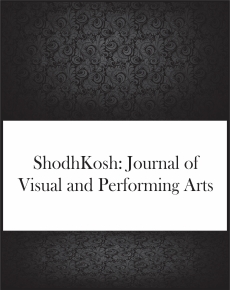If you face issue in Submission Online, please send manuscript to email: editor@ShodhKosh.com
Quick Access
Follow Us On



| Journal title | ShodhKosh: Journal of Visual and Performing Arts |
| Initials | ShodhKosh |
| Abbreviation | ShodhKosh J. Vis. Per. Arts |
| Frequency | Two issues per year |
| DOI | prefix 10.29121 |
| Online ISSN | 2582-7472 |
| Editor-in-chief | Dr. Kumkum Bharadwaj (Associates Professor (HOD) in Fine Arts, Maharani Laxmibai Girls P.G. College, Indore, India) |
| Managing Editor | Dr. Tina Porwal (Ph.D., Maharani Laxmibai Girls P.G. College, Indore, India) |
| Publisher | Granthaalayah Publications and Printers |
| Indexing Database | CrossRef, CrossMark, Google Scholar, Portico, Dimensions, PKP Preservation Network (PKP PN), Index Copernicus, PKP Index |
| Language of Publication | English | Hindi |
ShodhKosh: Journal of Visual and Performing Arts, is a half-yearly journal of visual and performing arts, in which research papers are published in Hindi and English language. This journal combines all topics related to Arts. The main objective of the journal is to make academics, scholars and students studying all aspects of arts. Through the journal, we want to provide the form of a repository by collecting all research papers related to the subjects of all arts. And this is our main objective.
The journal invites research works based on real important and difficult elements related to visual and performing arts. The journal mainly encourages a series of own views of important subjects. The key subject consists of:
These topics are addressed in full-length academic articles, critical statements on current issues, developmental practice, and reviews of books and live/media-based visual and performing arts.
The journal presents an innovative platform for researchers, students, practitioners, and educators to both learn from and contribute to the field. All articles are subject to initial Editor screening and then a rigorous double-blind peer-review process before publication.
शोधकोष: दृश्य और प्रदर्शन कलाओं की अर्धवार्षिक पत्रिका है, जिसमे हिंदी व अंग्रेजी भाषा में शोध पत्रों का प्रकाशन किया जाता है। इस पत्रिका में सभी प्रकार की कलाओं से सम्बंधित विषयों को संयोजित किया गया है। पत्रिका का मुख्य उद्देश्य शिक्षाविदों, शोधकर्ताओं व अध्ययन रत विद्यार्थियों को कला के सभी आयामों से अवगत करवाना है। पत्रिका के द्वारा हम सभी कलाओं के विषयों से सम्बंधित शोध पत्रों को संग्रहित करके एक कोष का रूप प्रदान करना चाहते है, यही लक्ष्य है।
पत्रिका द्वारा दृश्य व प्रदर्शन कलाओं से समबन्धित वास्तविक महत्वपूर्ण व कठिन तथ्यों पर आधारित शोध कार्यो को आमंत्रित किया जाता है। पत्रिका मुख्य रूप से महत्वपूर्ण विषयों के स्वयं के दृष्टिकोण की श्रृंखला के विचारों को प्रोत्साहित करती है। विषयों में शामिल है:
इन विषयों को अकादमिक लेखों, वर्तमान मुद्दों पर महत्वपूर्ण वक्तव्य, विकासात्मक अभ्यास और पुस्तकों की समीक्षा और लाइव / मीडिया-आधारित दृश्य और प्रदर्शन कला से संबोधित किया जायेगा।
पत्रिका द्वारा शिक्षकों, शोधकर्ताओं व् अध्ययन रत विद्यार्थियों के लिए एक अभिनव मंच प्रस्तुत किया जायेगा जिसमे वे अतीत वर्तमान और भविष्य में होने वाली संभावनाओं को अपने विषयों से सम्बंधित नविन अभ्यास द्वारा शोध के क्षेत्र में अपना अमूल्य एवं विशिष्ट योगदान देने में समर्थ होंगे।
सभी लेख प्रारंभिक संपादक स्क्रीनिंग और फिर प्रकाशन से पहले एक सख्त डबल-ब्लाइंड पीयर-रिव्यू प्रक्रिया के अधीन चयन किये जाएंगे।
If you face issue in Submission Online, please send manuscript to email: editor@ShodhKosh.com
Quick Access
Follow Us On


|